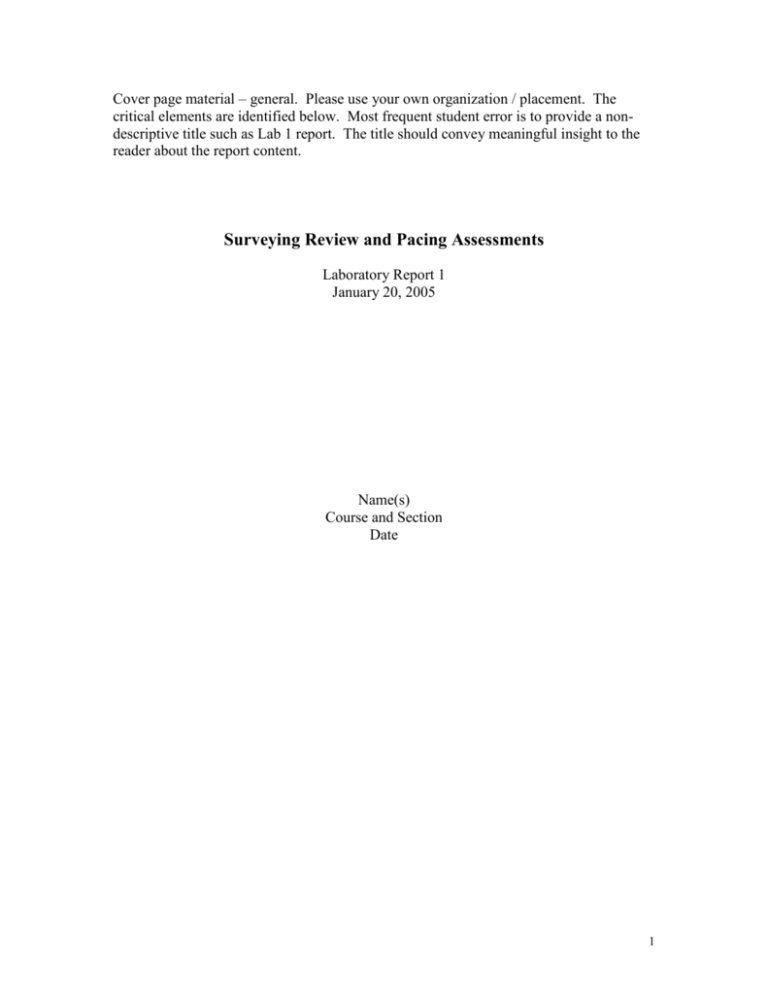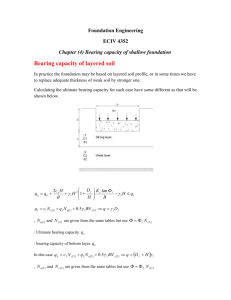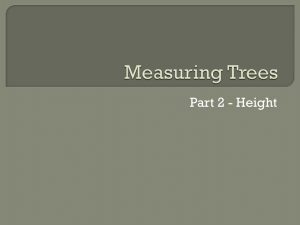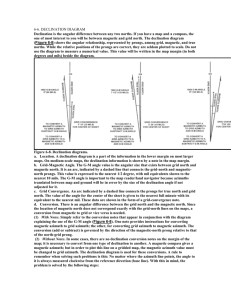Surveying Review & Pacing Assessments Lab Report
advertisement

Cover page material – general. Please use your own organization / placement. The critical elements are identified below. Most frequent student error is to provide a nondescriptive title such as Lab 1 report. The title should convey meaningful insight to the reader about the report content. Surveying Review and Pacing Assessments Laboratory Report 1 January 20, 2005 Name(s) Course and Section Date 1 CE 111 Lab 1 (Sample Laboratory report prepared by E. Kannel) Basic Application of Mathematical Tools in Surveying Objectives: The objectives of this laboratory are to acquaint students to the formats for reports, to review basic concepts in mathematics and statistics as they apply to surveying/engineering problems, and to examine the characteristics of surveying errors within an existing data set. The complete laboratory statement is attached as Appendix B. Section 1: Construction layout problem Section 1 – A requires the development and solution of linear functions that may be encountered in surveying practice. Given: Line 1 has two points with known coordinates . X=135.50, Y =450.52 and X = 185.48, Y = 678.44 Line 2 is at an angle of 60O 00’ from the positive Y axis (or 60O 00’ from North which is referred to as the azimuth in surveying). A single point is known on this line. It is X = 455.25, Y = 570.75 Determine the intersection point of the lines. (The sketch is not re-shown here.) Find equation of line: Use general format: (Y – Y1)/(X – X1) = (Y2 – Y1)/(X2 – X1) (Y – 450.52) / (X - 135.50) = (678.44 – 450.52) / (185.48 - 135.50) so: Y = 4.56022X – 167.39 Eq. 1 Use slope point form for Eq. 2: Slope = cotan(60O ) = tan(300 ) = 0.57735 Find intercept Y = mX + b Since the slope, and (X,Y) are known, solve for b 570.75 = 0.57735*(455.25) + b b= 307.91 Equation 2 is: Y = 0.57735 X + 307.91 Eq. 2 Solving Eqs 1 and 2 simultaneously for X and Y provides the point of intersection (PI): PI= : X = 119.34, Y = 376.81 ________________________________ 2 Section 1 – Part B Questions (Full questions are in Appendix) 1) Why change coordinates? By shifting the coordinate system much smaller numbers were involved, making it easier to compute and record steps. ( To students, switching a key coordinate to (0,0), or assuming a different North direction can minimize computations in several problem types). 2) When we have a non-linear function, many problems may have multiple solutions. We must be careful. An obvious example is when using the quadratic equation or solving angles from trigonometric equations, arcsines, arccosines, etc. 3 ) The author states that the slope of the line = cotangent of the bearing angle or the azimuth angle ( bottom line, page 570). In problem A-4 line ML is said to have a bearing angle of S 75o 10’ 30” E. Equation 1 (page 575) shows that relationship, but in the next equation the slope shows as a - 0.264678. By observing the sketch, the author used the correct slope (negative), but the calculator, using bearing angle would have given an incorrect answer. Additional material from the instructor. The following detail would not have been expected in your response. A computer program would have to check to determine which quadrant the line was in to know if the sign should be positive or negative when bearing angles are used. How can we avoid the above problem. The answer is “ use the cotangent of the azimuth angle rather than the cotangent of the bearing angle of the line. Observe an example when the bearings and azimuths are used. Case I B A Bearing = N 60 0 E = Azimuth of 60 0 Case II A B Bearing = S 60o E = Azimuth = (180 – 60) = 120 0 Bearing I) N 60o E II) S 60o E Azimuth 600 120o SLOPE (Cotangent of Bearing) 0.577… 0.577… SLOPE (Cotangent of Azimuth) 0.577… -0.577 Using the cotangent of the azimuth angle in the calculator/computer automatically yields the correct sign for the slope of the line, but the same is not true when the bearing angle is used. The calculator doesn’t show the cotangent, but we could use the comparable expression: cot(azimuth) = tan(90 – azimuth). Notice that in Case II: tan(90-120)= tan(-30 0 ) = -0.577… 3 Section 2 Variability of Measurements The pacing data were obtained form the CE 111 web page. 2.a As shown in Table 1, the data were grouped using bin limits at -3.5, -2.5, -1.5, -0.5, +0.5, +1.5, +2.5, and + 3.5. Since the bin limit includes the upper end value of a range, the bin labeled as 0.5 would contain all observations with errors per 100 feet from -0.49 feet per 100 feet to +0.5 feet per 100 feet. The average of this bin would generally be zero. Figure 1 shows the resulting graphic. Table 1 Error per 100 foot distribution summary Bin -3.5 -2.5 -1.5 -0.5 0.5 1.5 2.5 More Frequency 1 2 5 6 6 5 3 2 Histogram 7 Frequency 6 5 4 3 2 1 0 -2.5 -1.5 -0.5 0.5 1.5 2.5 3.5 More Error per 100 feet Figure 1 Pacing error distribution for beginning surveyors As expected, the errors center around the 0 mark, labeled as the 0.5 bar. 4 2.b Statistical curve characteristics You should have a “bell shaped” curve. Normally we expect the random error to be distributed about a mean of zero. The more variability in the data, the wider is the bell. For large samples of normally distributed data we expect approximately 68% of the points to be within +/- one standard deviation of the mean. Approximately 95 percent should be within two standard deviations of the mean. 2.c. Basic statistics on calculator For the three points: -1.04, -2.30, 1.32 feet of error per 100 feet, the following values were found: Mean = -0.67 ft Standard Dev. = 1.84 ft Variance = 3.38 ft2 St. error of mean = 1.06 ft My calculator is a (….no advertising here). I did know how to use this before. 2.d) Determine the number of students achieving less than 1 and 50 accuracy To achieve 1 in 50 precision the maximum error per 100 feet is: 1 / 50 = X / 100 Therefore X = 2 feet per 100 feet. Using the Sort function on the data set, 9 students out of 30, reported more error than +/- 2 feet. They should have re-calibrated their pace length. 2.e) Inconsistencies in data reporting Considering that we are experiencing 1 foot of error per 50 feet or per 100 feet, some students appear to have more confidence in their numbers than are justified. Measured lengths to the 0.001 or 0.01 foot (data points 2 and 3, for examples) are unrealistic precisions. Even distances to the nearest 0.1 feet are misleading. If the error is to nearest 0.1 foot in a 100 foot distance , the reviewer might expect there to be no more than 1 foot in 1000 feet of distance. We don’t expect that precision from pacing. Section 3 Calibration of pace length (Instructors note: I have not tried to fill in this section with individual data and analysis. The first two sections should give you an idea of the expectations about report organization and materials to include. Each question is answered and some discussion is provided about the result. These laboratory reports are not just fill in the blank forms for a step-by-step process. Instead you are given freedom to organize your report and to assess the results. During the semester you will not be graded so much on how quickly you can set up an instrument in the lab, or how accurately you can measure an angle, as you will be evaluated on how well you organize and record data, recognize what the values represent, judge whether the data meet standards for data collection, and present your results. 5 You might close your report with a summary of what you have learned, as follows. Conclusion Section 1of the laboratory on mathematical analysis was just a review Section 2 was most beneficial. Several students will need to re-calibrate their pace to achieve 1 in 50 pacing accuracy. I concluded that I will need to check out my calculator manual more carefully to learn to use it for standard statistical operations. (General comment to students - a conclusion section should state the author’s conclusions based on the data collection and analysis developed within the report. It should not introduce new information or resources. If outside resources are referenced, those materials should be carefully documented in a reference/bibliography section. Be sure to provide all the elements that are to be included in standard referencing procedures. This includes web references. Web references often have individual authors, corporate identities, titles, and dates. A general reference that does not help the reader find the material you are referencing is not acceptable. ) Appendices may be appropriate in some cases. One use would be to place the original problem statement there for the reviewer and yourself. 6







